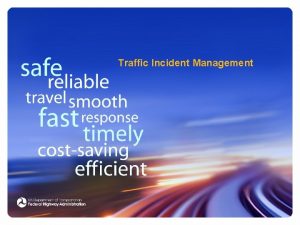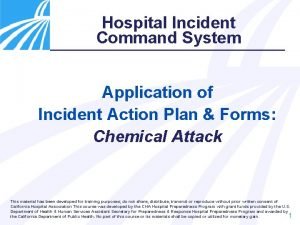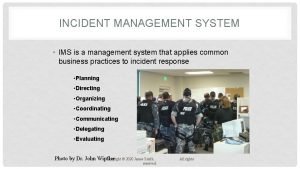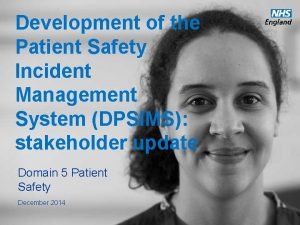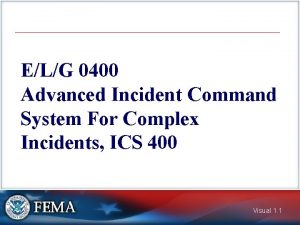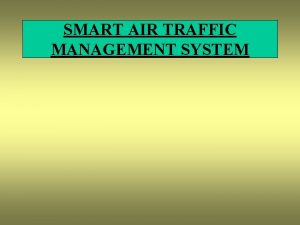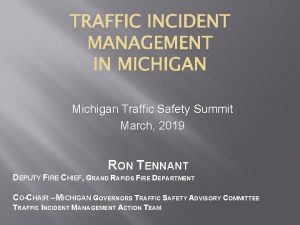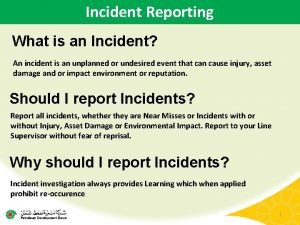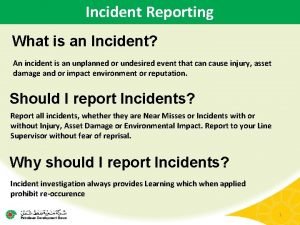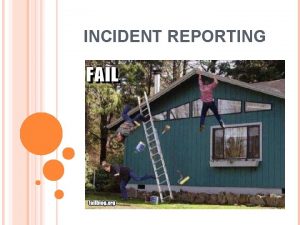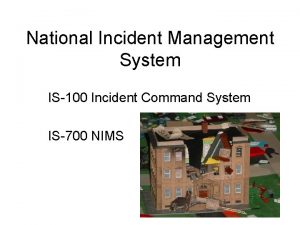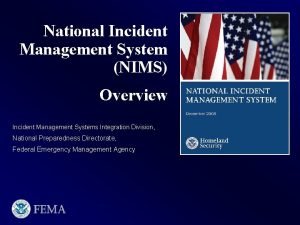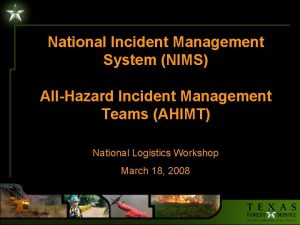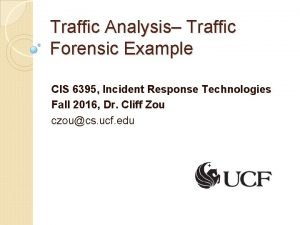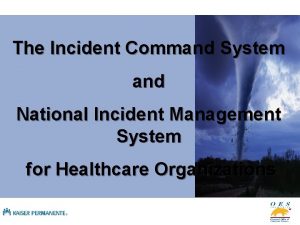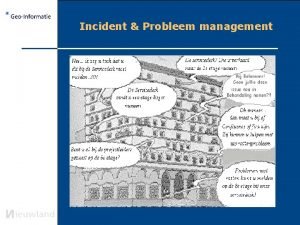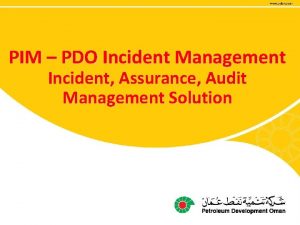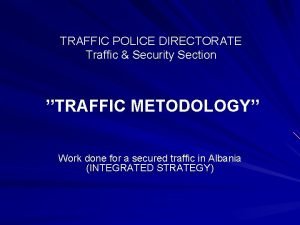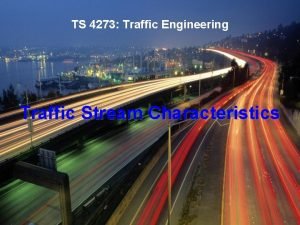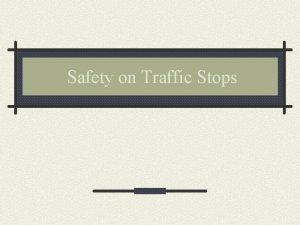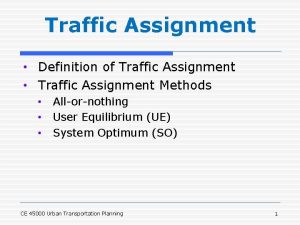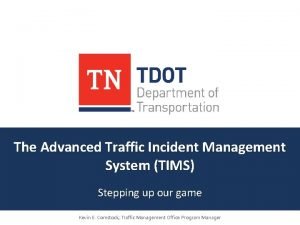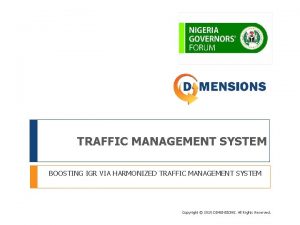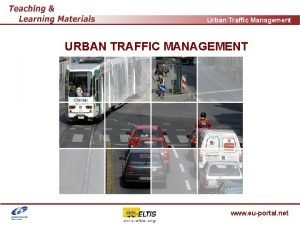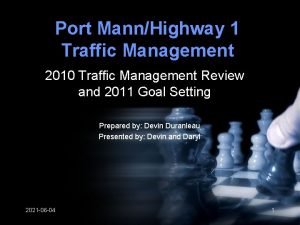Development of a Traffic Incident Management System for




























































- Slides: 60

Development of a Traffic Incident Management System for Contending with Non-recurrent Highway Congestion Woon Kim, Directed by Dr. Gang-Len Chang March 11, 2014 Dept. of Civil and Environmental Engineering University of Maryland, College Park 1

Overview v Introduction v Component 1: Incident response management strategies v Component 2: Prediction models for clearance times v Component 3: A detour decision support system v Contributions, future research, and conclusions 2

Introduction Research Background § Non-recurrent traffic congestion due to incidents has contributed up to 60 percent of the total freeway corridor delay in the United States (Lindley, 1987). § About 25 percent of congestion in the U. S. is incident -related (FHWA, 2005). The starting time and duration of non-recurrent congestion, due mainly to incidents, are random in nature. Thus, it is critical to have an efficient and effective incident management system. 3

Introduction Key Tasks in an Incident Management System v An optimal deployment strategy for response units v Estimation of required clearance times for reported incidents v Detour feasibility analysis v Detour optimization analysis v Provide travel time information to roadway users § queue, delay and travel time analysis 4

Introduction Incident Management System Dispatching ERU Collecting/Updating Incident & Traffic related Data 1. Incident Response Management Strategies 2. Prediction Models for Clearance Times Predicting Incident Duration Detour feasibility analysis system Incident Detection Estimating Clearance Time 3. A Detour Decision Support System Detour Optimization Evaluating Traffic & Incident Impact to the Network Detour? Establishing Feasible Detour Plans Analyzing the Necessity of Detour Operations YES Implementing Optimal Detour Plans NO Output Inform to Highway Users 5

Introduction Needs for Each Component 1. Incident Response Management Strategies § To maximize contributions of incident response units with limited resources by assigning them to optimal locations. 2. Prediction Models for Clearance Times § To contend with stochastic nature of clearance times so as to maximize the system’s operational reliability. 3. A Detour Decision Support System § To facilitate responsible agencies to perform efficient traffic management in real time operations. 6

Introduction Research Objectives 1. Incident Response Management Strategies § Develop a deployment strategy for incident response units to minimize the total incident-induced delay 2. Prediction Models for Clearance Times § Develop a reliable model to estimate the clearance duration of a detected incident, and to identify critical contributing factors as well as their interrelationships 3. A Detour Decision Support System § Develop a detour decision support model for control center staff to determine the necessity of detouring traffic 7

1. Incident Response Management Strategies

1. Incident Response Management Strategies Literature Review v Facility location problem § how many response units are needed? § where should they be allocated in response to the temporal and spatial distribution of incidents? 1) Covering models (Toregas et al. , 1971; Schilling et al. , 1979; Hogan and Re. Velle, 1986; Nair and Miller-Hooks, 2009) 2) P-median models; and (Hakimi, 1964; Carson and Batta, 1990; Haghani et al. , 2003; Yang et al. , 2005) 3) P-center models (Sylvester, 1857; Garfinkel et al. , 1977; Re. Velle and Hogan, 1989; Talwar, 2002) v Minimize the number of service stations, the total operational costs, or to maximize the demand (incidents) covered by the pre-determined number of facilities 9

1. Incident Response Management Strategies Data Sources v Incident management program operated by Maryland state highway administration (MDSHA) § Coordinated Highways Action Response Team (CHART) • Has documented incident-related information over the past two decades • Date/time, location, nature, involved vehicles, lane closure… 10

1. Incident Response Management Strategies Effectiveness of CHART responded approximately 81 % (22, 796/28, 345) of incidents during last two years Does the CHART involvement matter? Mean on CT (mins) w/o CHART w/ CHART 37. 91 27. 51 CHART reduced the avg. clearance time by 27 % Does the prompt CHART response matter? First responder Others CHART Mean on CT (mins) 39. 49 21. 85 CHART reduced the avg. clearance time by 45 % 11

1. Incident Response Management Strategies Needs for Research v The efficient response of CHART can contribute to the reduction in not only the response time but also the clearance time reduction in delay v However, not all incidents can be promptly responded by CHART due to their limited resources v Therefore, it is critical to develop a strategy to optimally deploy available response units so as to maximize their contributions 12

1. Incident Response Management Strategies Model Construction v Inputs § Incident distribution, incident duration, lane blockage information, traffic volume, capacity, and available resources v Objective function § Minimize the total delay induced by incidents v Constraints § Every freeway segment must be served by one unit § Response units can only be dispatched from location i if they are stationed there § The total number of response units is limited by available resources v Outputs § Assigned station and coverage for each unit 13

1. Incident Response Management Strategies Relations between Incident Duration and Total Delay Cumulative Arrivals and Departures Arrival rate, q f (Ti , rc, c, q) Departure rate, c Departure rate, rc 2 (Reduced capacity 2) B Departure rate, rc 1 (Reduced capacity 1) A onset A B response cleared recovered early cleared recovered Time Reduced delay due to additional lanes open Reduced delay due to reduced clearance duration 14

1. Incident Response Management Strategies Model Formulation Objective Function: Min total delay for responded incidents Total Delay 1. Delay from incidents occurring at node j (Olmstead, 1996) Tij : Response Time + Clearance time Stochastic nature 2. Response time and clearance time (Olmstead, 1996) CHART is not involved CHART is involved and first responder CHART is involved but not the first responder 14

1. Incident Response Management Strategies Model Formulation (cont’d) Constraints: 1. Every freeway segment must be served 2. Response units can only be dispatched from location i if they are stationed there (yi = 1) 3. The total number of available response units is limited by available resources (R) 15

1. Incident Response Management Strategies Empirical Study v Segments of I-70, I-270 and US 15 in MD Site Characteristics § 63 miles § Radial shape of roads § Frederick, Howard, and Carroll Counties US 15 I-70 I-270 Highway Incident Management § TOC-7 § 3 units § Operation Hours: 5 AM – 9 PM on weekday Ø Study Period: AM peak (7 AM – 9: 30 AM on weekday) 16

1. Incident Response Management Strategies Incident Frequency Distribution Incident frequencies fluctuate over the network ! 30 26 27 20 20 15 13 5 5 6 4 7 4 4 3 1 1 18&22 8 7 87&91 5 13 13 10 10 6 5 6 3 2 I-70 I-270 16&17 15&16 14&15 13&14 12&13 11&12 10&11 31&32 26&31 22&26 83&87 73&83 68&73 62&68 59&62 56&59 55&56 54&55 53&54 52&53 49&52 48&49 42&48 0 35&42 incident frequency 25 US 15 17

1. Incident Response Management Strategies Model output Analysis 1. Assigned station and service coverage for each unit 2. Average travel time (minutes) 9. 00 CHART current practice (7. 79 mins) Proposed model Minutes 8. 00 Traditional model 7. 00 6. 00 5. 00 min. avg. response time min. total delay fleet size 2 7. 88 8. 38 fleet size 3 6. 90 7. 51 fleet size 4 6. 22 fleet size 5 5. 89 5. 94 fleet size 6 5. 60 5. 83 fleet size 7 5. 40 5. 56 19

1. Incident Response Management Strategies Model output analysis (cont’d) 3. Total delay (veh-hr) 4, 850, 000 CHART current practice (5, 612, 805 veh-hr) Vehicle-hour 4, 800, 000 Proposed model 4, 750, 000 4, 700, 000 Traditional model 4, 650, 000 4, 600, 000 4, 550, 000 4, 500, 000 fleet size 2 min. avg. response time 4, 829, 998 min. total delay 4, 749, 141 fleet size 3 4, 729, 356 4, 659, 967 fleet size 4 4, 584, 707 fleet size 5 4, 567, 920 4, 566, 630 fleet size 6 4, 551, 095 4, 549, 114 fleet size 7 4, 541, 785 4, 532, 457 20

Incident Management System Dispatching ERU Collecting/Updating Incident & Traffic related Data 1. Incident Response Management Strategies 2. Prediction Models for Clearance Times Predicting Incident Duration Detour feasibility analysis system Incident Detection Estimating Clearance Time 3. A Detour Decision Support System Detour Optimization Evaluating Traffic & Incident Impact to the Network Detour? Establishing Feasible Detour Plans Analyzing the Necessity of Detour Operations YES Implementing Optimal Detour Plans NO Output Inform to Highway Users 21

2. Prediction Models for Clearance Times

2. Prediction Models for Clearance Times A Model for Estimating Clearance Times Why do we need such a model? v Key input for the incident management system § § Optimal deployment strategy analysis Detour feasibility analysis Detour optimization analysis Traveler information – queue, delay and travel time analysis v However, the required clearance time for a reported incident is very difficult to reliably predict in advance. 23

2. Prediction Models for Clearance Times Challenge to Predict Clearance Times Frequency Ratio <=30 3870 65% 30 -60 1176 20% 60 -90 397 7% 0 90 -120 138 2% < (1 10 0, 2 (2 0] 0, 3 (3 0] 0, 4 (4 0] 0, 5 (5 0] 0, 6 (6 0] 0, 7 (7 0] 0, 8 (8 0] 0, (9 90 0 ] (1 , 10 00 0] (1 , 11 10 0] (1 , 12 20 0] (1 , 13 30 0] (1 , 14 40 0] (1 , 15 50 0] (1 , 16 60 0] (1 , 17 70 0] (1 , 18 80 0] (1 , 19 90 0] , 2 00 >2 ] 00 v Skewed shape and distributed in a wide range CT (mins) >120 344 6% total 5925 100% 1800 1600 Frequency 1400 1200 1000 800 600 400 200 Clearance Time § Difficult to fit with a continuous or discrete distribution § Most statistical models cannot perform well • They tend to focus on the major classes of the data However, most studies in the literature applied statistical approaches to develop a model 24

2. Prediction Models for Clearance Times Literature Review 1) Probabilistic Distributions (Golob et al. , 1987; Giuliano, In the most literature 1989; Garib et al. , 1997; Sullivan, 1997; Ozbay and Kachroo, 1999) § Using limited scale data § No validation for models 2) Conditional Probability Models (Nam and Mannering, 2000; Boyles et al. , 2007) 3) Regression Models (Khattak et al. , 1995; Giuliano, 1989; Garib et al. , 1997; Ozbay and Kachroo, 1999) The proposed Model is 4) Decision/Classification Tree Models (Ozbay and Kachroo, ü tackling heterogeneity in most incident data sets 1999; Smith et al. in 2001; Ozbay and Noyan in 2006) ü enhancing prediction accuracies; and 5) Discrete Choice or Classification Models (Lin et al. , 2004) ü assessing the prediction model’s robustness for 6) Time Sequential Models (Khattak et al. , 1995; Wei and Lee, 2007)different data sets 7) Unconventional Models (Wang et al. , 2005; Wu et al. , 2011) 25

2. Prediction Models for Clearance Times Flowchart to Develop the Proposed Model Phase 1: Filter outliers Non-statistics-based approach No assumption for distributions Phase 2: Sequential Classifiers with Association Rules (SCAR) An integrated system for predicting incident clearance times Phase 3: Develop Supplemental models Focusing on intermediate CT and incidents that cannot be categorized by SCAR 26

2. Prediction Models for Clearance Times Phase 1 – Filter Outliers v PAM: Partitioning Around Medoids (Kaufman and Rousseeuw, 1990) § Medoids: most centrally located elements § Goal: detecting a group of clusters including a small number of elements 36/6000 incidents are selected as outliers 27

2. Prediction Models for Clearance Times Flowchart to Develop the Proposed Model Phase 1: Filter outliers • Short: ≤ 30 mins • Intermediate: 30 -120 mins • Long: ≥ 120 mins Phase 2: Sequential Classifiers with Association Rules (SCAR) An integrated system for predicting incident clearance times Phase 3: Develop Supplemental models 28

2. Prediction Models for Clearance Times Association Rules (Agrawal et al. , 1993) v {personal injury, rainy} → {intermediate CT} antecedent consequent LHS RHS X Y 6 3 supp(X)=6 conf(X→ Y) = 3/6 = 0. 5 29

2. Prediction Models for Clearance Times Procedure to Construct the SCAR System Phase 1 Extract rules using an AR technique Any significan t rules? Phase 2 NO Phase 3 YES Build a classifier using the best set of ARs Filter out classified cases based on the developed set of classifiers 30

2. Prediction Models for Clearance Times Illustration of the SCAR System An Incident Is Detected (TOC 3 & Minor lane closure & no info. for pavement condition) (AOC & 12 lanes on both & on US-50) (on weekday & disabled veh & CHART detected) Yes or or AR 1 AR 2 AR 3 Classifier 1 No Short (≤ 30 mins) (2 veh involved & fatality) or (during daytime & minor road & fatality) Yes Short (≤ 30 mins) AR 1 AR 2 Classifier 2 No Continued… 31

2. Prediction Models for Clearance Times Phase 2 - Model Results v 44 Classifiers v Each consists of 2 or 3 ARs v About 72% of samples can be explained with SCAR v Accuracies for each category of clearance duration Clearance Class # of Time ratio Classifiers Short 64. 98% 27 Intermediate 28. 95% 13 Long 6. 07% 4 Accuracy Train Test 87. 70% 90. 37% 90. 50% 92. 51% 75. 86% 79. 66% 30 -120 mins 32

2. Prediction Models for Clearance Times Flowchart to Develop the Proposed Model Phase 1: Filter outliers Phase 2: Sequential Classifiers with Association Rules (SCAR) An integrated system for predicting incident clearance times Phase 3: Develop Supplemental models To predict CT for incidents that cannot be classified by SCAR To classify predicted intermediate CT into shorter intervals 33

2. Prediction Models for Clearance Times Phase 3 – Developing Supplemental Models 1. A model for data not classified by SCAR § § § <= 30 minutes 30 – 60 minutes 60 – 90 minutes 90 – 120 minutes > 120 minutes 2. A model to classify the predicted intermediate clearance times into smaller intervals § Intermediate-sub 1: 30 – 60 minutes § Intermediate-sub 2: 60 – 90 minutes § Intermediate-sub 3: 90 – 120 minutes Support Vector Machine and Random Forests are applied 34

2. Prediction Models for Clearance Times Start: Input Incident Info. Illustration of the Proposed System SCAR Yes Supplemental Model 2 30 -60 mins 60 -90 mins 90 -120 mins Is an intermediate incident? Can be classified by SCAR? No No Supplemental Model 1 Output 35

2. Prediction Models for Clearance Times MOEs to Evaluate the System’s Performance Contingency Table (cij) Clearance Duration (minutes) Prediction ≤ 30 30 – 60 60 – 90 90 – 120 > 120 ≤ 30 1068 130 81 13 8 Observation 30 – 60 – 90 – 60 90 120 95 20 3 146 50 16 96 33 9 37 23 9 12 9 8 > 120 11 23 5 5 60 Accuracy Weights (wij) Clearance Duration (minutes) Estimation/ Prediction ≤ 30 30 – 60 60 – 90 90 – 120 > 120 ≤ 30 1 0. 75 0. 25 0 Observation 30 - 90 – 60 - 90 60 120 0 1 0 0 0. 75 1 0 0. 5 0. 75 1 0. 25 0. 75 > 120 0 0 1 36

2. Prediction Models for Clearance Times MOEs to Evaluate the System’s Performance Contingency Table (cij) Clearance Duration (minutes) Prediction ≤ 30 30 – 60 60 – 90 90 – 120 > 120 ≤ 30 1068 130 81 13 8 Observation 30 – 60 – 90 – 60 90 120 95 20 3 146 50 16 96 33 9 37 23 9 12 9 8 > 120 11 23 5 5 60 Weights (wij) Clearance Duration (minutes) Estimation/ Prediction ≤ 30 30 – 60 60 – 90 90 – 120 > 120 ≤ 30 1 0. 75 0. 25 0 Observation 30 - 90 – 60 - 90 60 120 0 1 0 0 0. 75 1 0 0. 5 0. 75 1 0. 25 0. 75 Acceptability > 120 0 0 1 wij: weights for cells (i, j) cij: number of cases in a cell (i, j) 37

2. Prediction Models for Clearance Times Overall System Performance Incident Categories Minor Intermediate-sub 1 Intermediate-sub 2 Intermediate-sub 3 Major Total Clearance Duration (minutes) <= 30 30 – 60 60 – 90 90 – 120 + Class ratio 65. 0% 20. 0% 6. 6% 2. 4% 6. 0% 100. 0% Accuracy Train 80. 3% 38. 1% 35. 9% 46. 2% 57. 5% 66. 7% Test 82. 2% 37. 8% 24. 4% 20. 0% 57. 7% 66. 8% Acceptability Train 92. 0% 58. 0% 45. 0% 54. 8% 57. 5% 79. 1% Test 93. 0% 62. 2% 40. 7% 33. 3% 57. 7% 80. 2% v Better than five comparable models developed using support vector regression, random forests, and multiple linear regression, in terms of accuracy and acceptability 38

Incident Management System Dispatching ERU Collecting/Updating Incident & Traffic related Data 1. Incident Response Management Strategies 2. Prediction Models for Clearance Times Predicting Incident Duration Detour feasibility analysis system Incident Detection Estimating Clearance Time 3. A Detour Decision Support System Detour Optimization Evaluating Traffic & Incident Impact to the Network Detour? Establishing Feasible Detour Plans Analyzing the Necessity of Detour Operations YES Implementing Optimal Detour Plans NO Output Inform to Highway Users 39

3. A Detour Decision Support System

3. Detour Decision Support System Study Background Most states consider only § Incident duration > 30 minutes § Complete road closure The proposed model : ü Account for more critical factors § Traffic volumes, benefit, cost, safety, travel times, etc. ü Allow the decision maker to place different weights to different factors, based on the either resource constraints or priority. 41

3. Detour Decision Support System The Proposed System Architecture (1) Standard Flowchart Analytical Hierarchy Process Initial Assessment to guarantee the detour will be beneficial in the roadway operation Decision Goal: Is Detouring Beneficial ? (2) Inputs by Users • Incident-related info • Traffic volume • Detour plan Input Information (3) Detour Rate > 0% NO No Detour YES (4) Benefit. Cost Ratio (5) Safety & Reliability Detour Accessibility Acceptability No Detour 42

3. Detour Decision Support System Simulation-based Analysis v To estimate the optimal diversion rate from the freeway mainline to mitigate the congestion at the incident segment § Concurrently adjust signal timings at the arterial intersections to best accommodate the detour traffic § Multi-objective functions • Max total throughput of the freeway corridor • Min total time of detour travelers on the detour route § Constraints • Control for signal timing (min green time) • Control diverging traffic (max diverging rate) 43

3. Detour Decision Support System The Proposed System Architecture (1) Second Assessment (4) to ensure the detour will be beneficial in various aspects Standard Flowchart Analytical Hierarchy Process Initial Assessment to guarantee the detour will be beneficial in the roadway operation Decision Goal: Is Detouring Beneficial ? (2) Inputs by Users • Incident-related info • Traffic volume • Detour plan Input Information (3) Detour Rate > 0% NO No Detour YES Benefit. Cost Ratio (5) Safety & Reliability Detour Accessibility Acceptability No Detour 44

3. Detour Decision Support System Decision Criteria on the Second Assessment v Benefit-Cost Ratio Input: Incident & Traffic Info. Estimate Benefits: Saved delay, fuel consumption, emission Estimate Costs: Operation & maintenance Output: B/C 45

3. Detour Decision Support System Decision Criteria on the Second Assessment v Safety and Reliability § Impacted area reduction in secondary incidents § Measured by the max queue length • A multiple linear regression model based on numerous variables regarding incident, location, heavy vehicle volumes, and traffic volumes (Kim et al. 2013) 46

3. Detour Decision Support System Decision Criteria on the Second Assessment v Accessibility § Traffic signals, stop signs and speed limits on the detour route § Measured by travel time v Acceptability § Depend on the characteristics of driving populations and timely supply of the real-time traffic information § Measured by the anticipated compliance rate (user input) 47

3. Detour Decision Support System The Proposed System Architecture (1) Second Assessment (4) to ensure the detour will be beneficial in various aspects Standard Flowchart Analytical Hierarchy Process Initial Assessment to guarantee the detour will be beneficial in the roadway operation Decision Goal: Is Detouring Beneficial ? (2) Inputs by Users • Incident-related info • Traffic volume • Detour plan Input Information (3) Detour Rate > 0% NO No Detour YES Benefit. Cost Ratio (5) Safety & Reliability Detour Accessibility No Detour Acceptability Final Decision 48

3. Detour Decision Support System Case Study Weights for Criteria Ø Benefit-cost ratio: 0. 31 Ø Accessibility: 0. 18 Ø Safety and reliability : 0. 31 Ø Acceptability: 0. 20 Scenario 1 • A Full Road Closure (3/3) • 60 minute-incident duration • System Recommendation: Detour operations are beneficial (recommended) with 60% confidence. • # of signals on detour route: 2 • Speed limit on detour route: 50 mph Scenario 2 • A Full Road Closure (3/3) • 90 minute-incident duration • System Recommendation: Detour operations are NOT beneficial (recommended) with 62% confidence. • # of signals on detour route: 5 • Speed limit on detour route: 40 mph 49

3. Detour Decision Support System Comparisons of Decisions by Agency Scenario No. Decision Criteria (used by agencies in the literature) Decisions by Agency 1 2 Scenario No. 1 2 3/3 optimal detour flow 0. 85 0. 54 3, 232 10, 163 Incident Duration (minutes) 60 NC DOT-main office Y total travel time (hr) w/ detour 90 total travel time (hr) Y w/o detour 3, 617 10, 182 NC DOT-Charlotte Y saved travel time (hr) Y 386 19 NJ DOT Y Y B/C w/ detour 14. 74 0. 60 Oregon DOT Y 0. 07 1. 68 NY DOT Y 1. 37 2. 24 FL DOT N ARTIMIS (Ohio/Kentucky) Y 1. 66 2. 59 Idaho (Ada County) Y 2. 52 Wisconsin DOT Not clear B/C w/o detour Y max queue w/ detour Y (mile) N max queue w/o Y detour (mile) travel time (min) via freeway Y travel time (min) via Not clear detour 6. 55 7. 52 Lane Blockage (# of closed lane(s)/total # of lanes) Decision by Proposed System Y N 50

3. Detour Decision Support System The System Flexibility with Relative Importance v Base scenario § 15 minutes incident duration with full lane blockage (3/3) B/C: 0. 31 S&R: 0. 31 Acces: 0. 18 Accep: 0. 20 B/C: 0. 18 S&R: 0. 20 Acces: 0. 31 Accep: 0. 31 B/C: 0. 25 S&R: 0. 25 Acces: 0. 25 Accep: 0. 25 Case A • Higher weights on B/C and safety and reliability • Detour operations are recommended with 58% confidence. Case B • Higher weights on accessibility and acceptability • Detour operations are Not recommended with 53% confidence. Case C • Equal weights on all factors • Detour operations are recommended with 53% confidence. 51

Contributions, Future Research, and Conclusions

1. Incident Response Management Strategies Contributions v Empirically investigated the effectiveness of a welloperated incident response program § An efficient response operation can also reduce the incident clearance duration and produce significant benefits. v Developed an efficient model for optimally allocating the available response units from a new perspective of minimizing the total incident-induced delay § The developed model’s performance and robustness have been confirmed from the extensive numerical results and the comparative study with the existing models and the current practice in Maryland 53

2. Prediction Models for Clearance Times Contributions (cont’d) v Developed an integrated system to provide a reliable prediction of the clearance duration for a detected incident. § Incident clearance duration is one of the essential parameters for estimating the resulting traffic impacts and assessing the operational efficiency v Provided some insightful information on the interrelationships between key factors contributed to incident duration and their collective impacts on clearance times § Would be useful for traffic agencies to plan and improve their incident management programs. 54

3. Detour Decision Support System Contributions (cont’d) v Provided operational guidelines and tools for responsible agencies to conduct their assessment of traffic diversion plans as well as design of control strategies during the incident management period v Developed an integrated system that can assess the necessity of traffic detour/diversion based on the comprehensive review of associated factors 55

Future Research v Enhancing reliability of the incident response management strategy § Considering the likelihood of having multiple incidents over a short time period § Taking into account of the stochastic nature of incident patterns § Investigating the pros and cons between the dispatching and patrolling strategies for different times of a day under various traffic conditions and incident patterns § Studying the optimal fleet size based on the benefit-cost analysis for a given incident distribution, resource constraints, and operational costs 56

Future Research (cont’d) v Enhancing computational efficiency for real-time operations of the detour decision support system § To supplement or replace simulation- or optimization- based models § To generate key traffic control parameters such as optimal diversion rate and reduced total travel time by detour operations. 57

Conclusions v My field experimental analysis has confirmed the need to contend daily non-recurrent congestion with an efficient and effective incident management program. § An efficient incident management needs to optimal use available resources, and best coordinate all responsible agencies. 58

Conclusions (cont’d) v This study enhanced the efficiency and effectiveness of the current traffic incident management system in Maryland by developing more reliable models embedded in the system. § An incident management system with the proposed key models, incident detection, and detour optimization tools can substantially reduce the delay, fuel consumption, and emission caused by incidents. § Such a system, if properly integrated with travel time information system, can substantially improve the quality and efficiency of commuters over congested highways. 59

Thank You Q & A
 Incident management quiz
Incident management quiz Incident objectives that drive incident operations
Incident objectives that drive incident operations Incomina
Incomina All traffic solutions
All traffic solutions Ims incident management
Ims incident management Safety incident management system
Safety incident management system Complex incident
Complex incident Traffic management system
Traffic management system Fspos vägledning för kontinuitetshantering
Fspos vägledning för kontinuitetshantering Typiska novell drag
Typiska novell drag Nationell inriktning för artificiell intelligens
Nationell inriktning för artificiell intelligens Vad står k.r.å.k.a.n för
Vad står k.r.å.k.a.n för Varför kallas perioden 1918-1939 för mellankrigstiden?
Varför kallas perioden 1918-1939 för mellankrigstiden? En lathund för arbete med kontinuitetshantering
En lathund för arbete med kontinuitetshantering Adressändring ideell förening
Adressändring ideell förening Personlig tidbok
Personlig tidbok Sura för anatom
Sura för anatom Vad är densitet
Vad är densitet Datorkunskap för nybörjare
Datorkunskap för nybörjare Tack för att ni lyssnade bild
Tack för att ni lyssnade bild Debatt mall
Debatt mall Magnetsjukhus
Magnetsjukhus Nyckelkompetenser för livslångt lärande
Nyckelkompetenser för livslångt lärande Påbyggnader för flakfordon
Påbyggnader för flakfordon Formel för lufttryck
Formel för lufttryck Svenskt ramverk för digital samverkan
Svenskt ramverk för digital samverkan Urban torhamn
Urban torhamn Presentera för publik crossboss
Presentera för publik crossboss Argument för teckenspråk som minoritetsspråk
Argument för teckenspråk som minoritetsspråk Plats för toran ark
Plats för toran ark Treserva lathund
Treserva lathund Fimbrietratt
Fimbrietratt Bästa kameran för astrofoto
Bästa kameran för astrofoto Cks
Cks Lågenergihus nyproduktion
Lågenergihus nyproduktion Bra mat för unga idrottare
Bra mat för unga idrottare Verktyg för automatisering av utbetalningar
Verktyg för automatisering av utbetalningar Rutin för avvikelsehantering
Rutin för avvikelsehantering Smärtskolan kunskap för livet
Smärtskolan kunskap för livet Ministerstyre för och nackdelar
Ministerstyre för och nackdelar Tack för att ni har lyssnat
Tack för att ni har lyssnat Referat mall
Referat mall Redogör för vad psykologi är
Redogör för vad psykologi är Matematisk modellering eksempel
Matematisk modellering eksempel Tack för att ni har lyssnat
Tack för att ni har lyssnat Borra hål för knoppar
Borra hål för knoppar Vilken grundregel finns det för tronföljden i sverige?
Vilken grundregel finns det för tronföljden i sverige? Varians formel
Varians formel Tack för att ni har lyssnat
Tack för att ni har lyssnat Rita perspektiv
Rita perspektiv Verksamhetsanalys exempel
Verksamhetsanalys exempel Tobinskatten för och nackdelar
Tobinskatten för och nackdelar Toppslätskivling dos
Toppslätskivling dos Handledning reflektionsmodellen
Handledning reflektionsmodellen Egg för emanuel
Egg för emanuel Elektronik för barn
Elektronik för barn Plagg i rom
Plagg i rom Strategi för svensk viltförvaltning
Strategi för svensk viltförvaltning Var 1721 för stormaktssverige
Var 1721 för stormaktssverige Indikation för kejsarsnitt på moderns önskan
Indikation för kejsarsnitt på moderns önskan Ro i rom pax
Ro i rom pax
